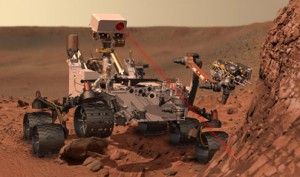
NASA’s newest astrobiology mission to Mars called the Mars Science Laboratory (MSL) is set to launch from Cape Canaveral Air Force Station in Florida on Saturday, November 26th. The one hour and 43 minute launch window opens at 10:02 a.m. EST.
It’s been more than eight years since NASA has sent a rover to explore Mars. And although both of the rovers from 2003’s Mars Exploration Rovers (MER) Mission, called Spirit and Opportunity, transmitted valuable data long after they were expected to expire, the newest rover, Curiosity, will be able to collect data far beyond the scope of any past mission.
Curiosity is a car-sized rover which will search areas of Mars for past or present conditions favorable for life, and conditions capable of preserving a record of life.
Curiosity consists of 10 instrument-based science experiments including a geology lab, a rock-vaporizing laser, a gas chromatograph mass spectrometer and several special cameras. Curiosity will use the laser to look inside rocks and release their gasses so its spectrometer can analyze and send the data back to Earth.
After launch, the spacecraft will travel approximately 354 million miles, landing on Mars in early August 2012.